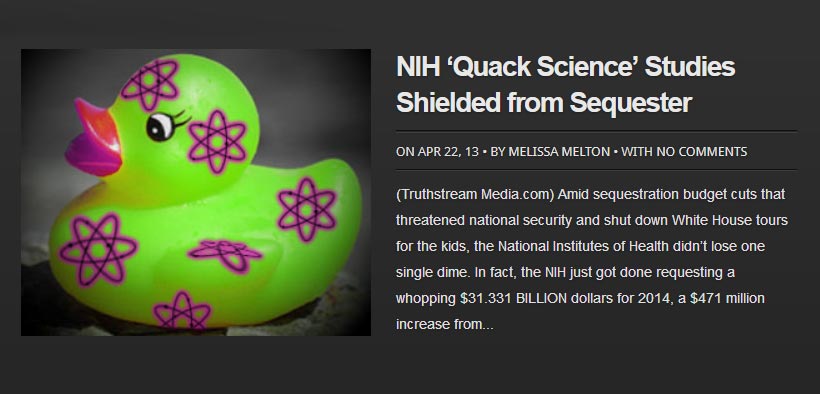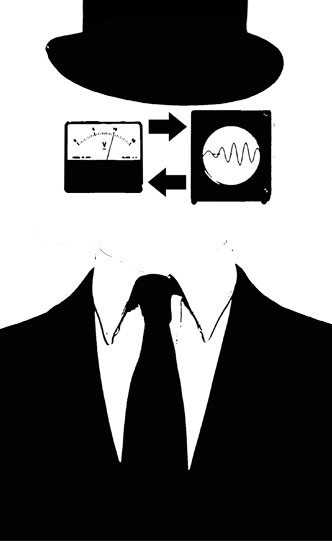NIH ‘Quack Science’ Studies Shielded from Sequester

Amid sequestration budget cuts that threatened national security and shut down White House tours for the kids, the National Institutes of Health didn’t lose one single dime.
In fact, the NIH just got done requesting a whopping $31.331 BILLION dollars for 2014, a $471 million increase from 2012.
In a fact sheet, the White House explains why cutting the NIH budget would be a terrible blow to America:
The National Institutes of Health (NIH) would be forced to delay or halt vital scientific projects and make hundreds of fewer research awards. Since each research award supports up to seven research positions, several thousand personnel could lose their jobs. Many projects would be difficult to pursue at reduced levels and would need to be cancelled, putting prior year investments at risk. These cuts would delay progress on the prevention of debilitating chronic conditions that are costly to society and delay development of more effective treatments for common and rare diseases affecting millions of Americans.
Not that many of us can even begin to fathom what that much money looks like, but just out of curiosity, what does $31 billion in “vital” National Institute of Health projects buy these days?
For starters, have you ever been deeply concerned with the effects of cocaine on the sexual habits of the Japanese quail? I know that’s a pressing scientific question right at the top of my vital research list. Okay, you got me, that was sarcasm. Apparently the NIH however is serious and shares this concern to the tune of $157,351 for a study on it called, “Enhancement of Sexual Motivation.”
I did a quickie random search just to see what else I could find. Here’s a fun smattering of goodies checked off the NIH research shopping list.
- “Away from Home and Out of School” (Rand Corporation: see below) — $718,389
- “Stratial Dopamine Release in Response to UV Light in Compulsive Tanners” — $214,594
- “The Important of Early Sexual Experiences Among Men Who Have Sex with Men” — $63,000
- “Age Difference in Distress Following Intrusive Thoughts” — $364,802
- “HPV and HTLV Infection in Female Sex Workers in Peru” — $106,123
Would the White House care to explain further on how Peru sex workers’ HPV infections ‘effect millions of Americans’ again?
In big brother-esque fashion, the Rand Corporation study “Away from Home and Out of School” actually tracks adolescent girls via GPS monitors which are described as “unobtrusive devices worn on the wrist or hip” in Minneapolis and San Diego under an ancillary study called “TAAG” aka the Trial of Activity of Adolescent Girls. There’s no way to type any of that without it sounding absolutely creepy.
For a few more seemingly obvious ones, how about a study on how drug-induced arthritis makes rats exercise less or a study on how dieting hamsters choose food over sex? How about research on why guys don’t like to use condoms? Only $423,500! Could distant prayer cure AIDS? The NIH paid $666,000 to find out. (Apparently it could not.) Have you ever wanted to know more about the habits of Chinese sex workers? The NIH was so curious, this topic was part of a $17 million study it funded between 2003 and 2008 alone.
Although it may be rather obvious, I feel the need to mention it anyway: taxpayers pay for this.
Just because, here are a few more that can be found in a condensed version in Senator Coburn’s Wastebook 2012:
- $350,000 for a study that showed golfers’ confidence can be boosted by imagining a bigger hole. (No. Really.)
- $939,771 for a study that found male fruit flies prefer younger female flies over the older ones.
- $666,905 for a study that claimed Watching TV reruns is good for you. (They even used the phrase “energizing”.)
Good to know. The list goes on and on and (literally) on. The NIH even funded research which claimed the tea party was a big tobacco creation, a study which NIH Director Francis Collins ended up backtracking on later during congressional testimony.
Why are we paying for this again? Oh yeah, that’s right, the White House says these projects are “vital”.
Far from being essential, many of these studies read like a primer in quack science. Hey! That’s it! How much can we get for a study on the role and prevalence of quack science in modern life (and government coffers)?
The Scientific American attempted to explain why sexed-out quails on smack are an important scientific subjects that can further our knowledge base about blah blah blah, but so are a lot of things, and when so many people across the country are hurting financially and we’ve apparently driven right off the fiscal cliff headfirst, is a tiny smidge of prioritization (and accountability) on the way down really too much to ask?












